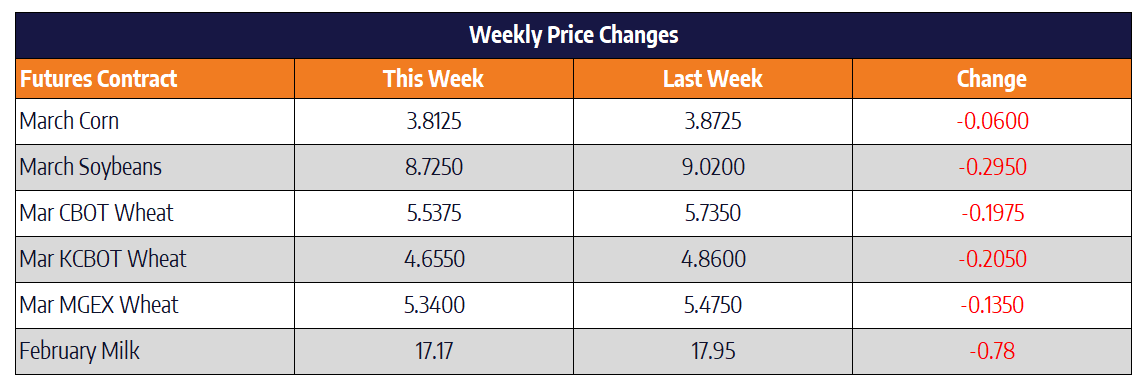Corn has worst week since early November.
March corn futures were down 6 cents this week to close at 381-1/4. Ethanol margins continue to weaken across the Midwest and are now near their lowest levels since this time last year. Basis levels, which are still historically strong, began to show weakness this week in parts of the corn belt. Reports of lines beginning to form to dump corn at some plants around the country, paired with basis backing off, suggest some farmer selling as of late. Those who were holding out for both the January crop report and the details of the phase one deal were under impressed with seemingly no pop in prices above 393 front month futures. Corn prices for the month of January were down 5-3/4 cents. Prices for the last three months have traded in about a 20-cent range. The market will be focused on South American weather moving forward as their second crop corn begins to be planted following soybean harvest.
Prospects for larger acres here in the US for 2020 are front of mind for new crop prices. December of 2020 corn, after gaping open lower on Monday, will finish their first week below $4 since early December of last year. As with any year, weather during the spring and summer will have the biggest impact on prices, but current futures levels lean heavily toward bigger corn acres this spring. Export demand remains weak, and further export estimate cuts from the USDA seem to be inevitable. Chinese demand may step in at lower price levels, but they are not expected to be huge corn buyers in 2020.
Soybeans continue the slide lower.
Soybean futures continued their free fall this week; March futures were 29-1/2 cents lower to close at 872-3/4. November futures closed at 912-1/4, down 26-1/2 cents on the week. Soybeans broke major support of 880 on Thursday, which could point to continued momentum lower in the short term. For the month of January, soybeans were down more than 82 cents. The lackluster details from the phase one trade deal announced in the middle of the month were the initial catalyst that sent the market sharply lower. The development of the coronavirus around the world has traders worried about a hit to world demand moving forward. Chinese markets will re-open Monday morning following their lunar new year celebrations. Traders will watch their market movement for a better feel of the overall severity of the coronavirus situation.
Also adding pressure to the soybean market is the start of a record soybean harvest in South America. The estimate for the Brazilian crop is hovering somewhere around the 120 million metric ton mark. If true, Brazil will overtake the US as the world’s top soybean producer. Harvest is estimated to be about 2% done in Brazil, this is slightly behind the pace of last year. Recent rainfalls are slightly impeding harvest, but the rains are welcomed by many especially those in far southern Brazil. The rains should bolster soil moisture levels for the corn crop which will be planted following soybean harvest. Given higher domestic prices and the currency discrepancy between the US dollar and the Brazilian Real, farmers are expected to be aggressive sellers right off the combine. The Brazilian Real hit a new record low on Friday, making Brazil very attractive in the world export market just as harvest begins.
Wheat has worst week since August.
March Chicago wheat futures were 19-3/4 cents lower on the week to close at 553-3/4. March KC futures were 20-1/2 cents lower on the week to finish at 465-1/2. Spring wheat futures were 13-3/4 cents lower to close at 533-3/4. The wheat market looks to be in correction mode following a more than 5-month bull market run. Going back to September, the Chicago wheat market gained over 125 cents at its peak last week above the 590 mark. Market worries about the severity of the coronavirus continue to grow as US airlines halted flights to and from China on Friday. There are more than 7,700 confirmed cases around the world with at least 170 deaths also confirmed. Cases are only expected to increase in the coming weeks, given the incubation period of the virus. The virus is a threat to overall grain demand across the world. Chinese market movement Monday morning could set not only wheat but other world market direction for the weeks to come.
Spot Cheese Unchanged – Class III Drags Lower
The block/barrel average was unchanged this week, but the block/barrel average finished a whopping 9.25 cents lower on the week with only 3 loads traded. The low volume on the spot market may be part of the driving force behind the steep drops we have seen this week. Butter prices put in reversal like price action with 28 loads trading on the day and prices pushing 4 cents higher in a bullish weekly reversal. Non-fat seems to have been rejected at $1.30/lb and prices pushed 1.25 cents lower to $1.24/lb today. There is a GDT on Tuesday of next week and we will have to see if the uptrend in global powder markets can continue. Whey prices dropped a penny today to finished the week unchanged at $0.365/lb.
Price action in the futures market was somewhat muted in contracts other than February, which dropped 18 cents on the day. Losses were fairly minimal in the more deferred contracts with some of them even trading higher on the day. The class III 2020 average closed at $17.59, down on the week. Price action still looks fairly corrective and makes sense given the current time of the year. Global Dairy Trade Auction and Exports next week will give us some new information.


